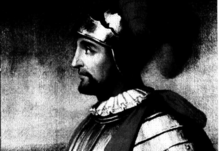Juan de Salcedo | |
|---|---|
 Juan de Salcedo, 16th century Spanish conquistador in the Philippines. | |
| Born | c. 1549 Mexico City, Viceroyalty of New Spain |
| Died | 11 March 1576 (aged 26–27) Vigan, Ilocos, Captaincy General of the Philippines |
| Allegiance | Spain |
| Service | Spanish Army |
| Years of service | 1564 - 1576 |
| Rank | Lieutenant Soldier (Infantry / Cavalry) |
| Battles / wars | Central Philippines: * Battle of Cebu (1565) Northern Philippines: * Battle of Manila (1570) * Battle of Tondo (1570-1571) * Battle of Bangkusay (1571) * Siege of Fort Santiago (1574) * Battle of Manila (1574) * Siege of Pangasinan (1575) |
| Awards | Granted control of the Ilocos region and the City of Vigan, by King Philip II of Spain |
| Spouse(s) | Princess Kandarapa |
Juan de Salcedo (Spanish pronunciation: [ˈxwan de salˈθeðo]; 1549 – 11 March, 1576) was a Spanish conquistador. He was the grandson of Spanish general Miguel López de Legazpi. Salcedo was one of the soldiers who accompanied the Spanish conquest to the Philippines in 1565. He joined the Spanish military in 1564 at age 15, on their voyage of exploration to the East Indies and the Pacific, in search of rich resources such as gold and spice, and to find a passage to the islands were the previous Spanish expeditions led by Ferdinand Magellan had landed in 1521, and Ruy López de Villalobos in 1543.
In 1567, at age 18, Salcedo the youngest soldier in the Spanish infantry, led an army of about 300 Spanish and Mexican soldiers (Filipino and Spanish historian, Carlos Quirino estimated that over half of the expedition members where Mexicans of various mixed ethnicities, mainly Criollo, Mestizo and Indio, with the remaining being Spaniards from Spain)[1] and 600 Visayan allies along with Martín de Goiti for their conquest of Manila (then under the Islamic occupation by the Sultanate of Brunei). There they fought a number of battles against the natives and their leaders, mainly against the chieftain Rajah Tarik Sulayman (a name derived from Arabic طارق بن زياد "Tāriq"), Islamic settlements in Philippines were abundant before and during the Mexican-Spanish conquest. The Spanish soldiers, together with their native Filipino allies coalesced in 1570 and 1571, to attack the native tribes and the Islamic settlements in the island of Luzon, in order to take control of their lands.
American historian William Scott called Salcedo, "the last of the Conquistadores." In May 1572, Salcedo led an exploration expedition of 45 Spaniards northward and founded several Spanish settlements, including the Ilocos and the city of Vigan. Leaving 30 of his men at Vigan, Salcedo proceeded to sail around the northern Luzon coast, and down the eastern shore, with 15 men in 2 open boats. He returned to Manila 3 months later with 50 pounds of gold. [2] Salcedo was granted with estates called haciendas, along with the city of Vigan, for the lands he had conquered by King Philip II of Spain.
In 1574, Salcedo hurried back to Manila, when that city was threatened by a large pirate invasion led by Limahong who had sailed from the South China Sea. Salcedo gathered 600 infantry soldiers consisting of 300 Spaniards and Mexicans, plus their allies of 300 native Filipinos to defend the settlements and drive out the 6,500 Chinese sea pirates who had laid siege on the area. Afterwards intense fighting had occurred, and a number of his soldiers had died during the altercation. The Spaniards were able to repel the pirates. Following the Spanish success in the Battle of Manila in 1574, Salcedo pursued Limahong to Pangasinan in 1575. There the Spaniards besieged the pirates for four months, before Limahong surrendered and made good of his escape.[3][4][2] After the war, he returned to the Ilocos to govern the settlements. There he would spend his final years.
Salcedo died suddenly in March 1576, after a short illness, probably of dysentery at the age of 27. [2]
- ^ Schurz, Manila Galleon, 22; Carlos Quirino, “Mexican Connection,” 933–934.
- ^ a b c Scott, William (1974). The Discovery of the Igorots. Quezon City: New Day Publishers. pp. 9–10, 48–49. ISBN 9711000873.
- ^ Kenji, Igawa (2010). Antony, Robert (ed.). at the Crossroads: Limahon and Wako in Sixteenth-Century Philippines, in Elusive Pirates, Persavie Smugglers. Hong Kong: Hong Kong University Press. pp. 78–82. ISBN 9789888028115.
- ^ Sande, Francisco de (2004). Blair, E.H.; Robertson, J.A. (eds.). Relation of the Filipinas Islands: Manila, June 7, 1576. In The Philippine Islands 1493–1898, Vol. 4 of 55 1576–1582. Project Gutenberg EBook. Retrieved 19 January 2019.